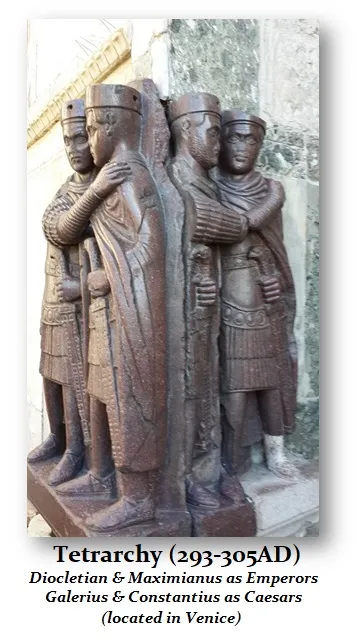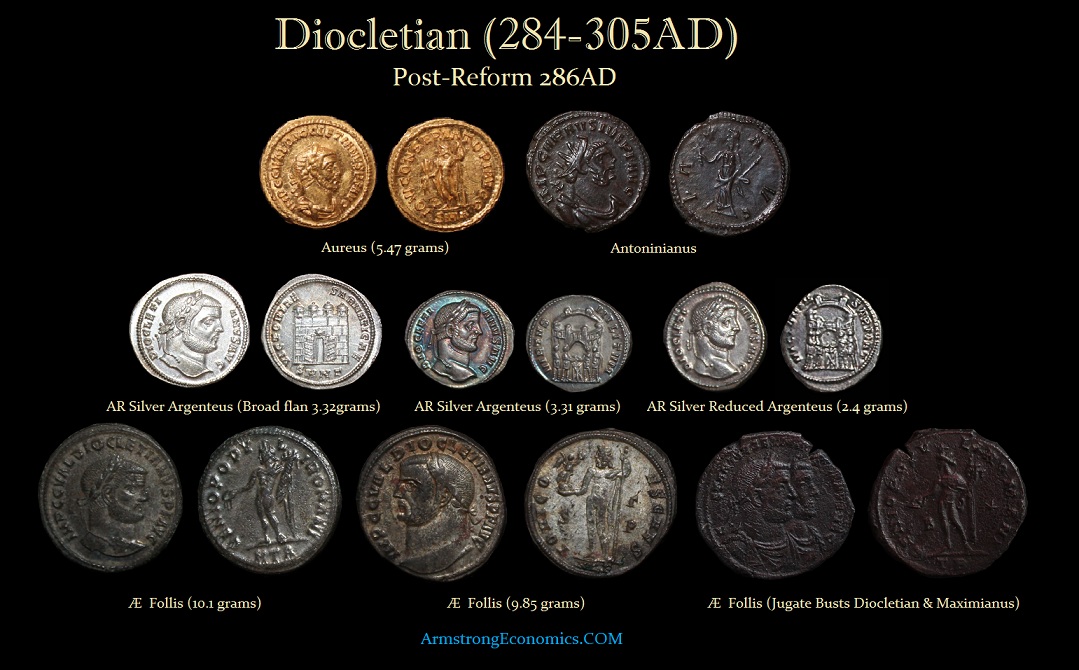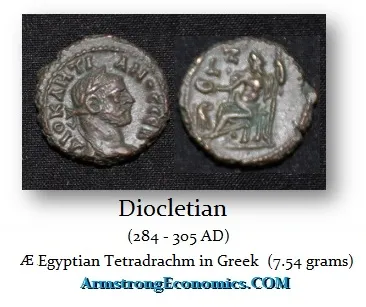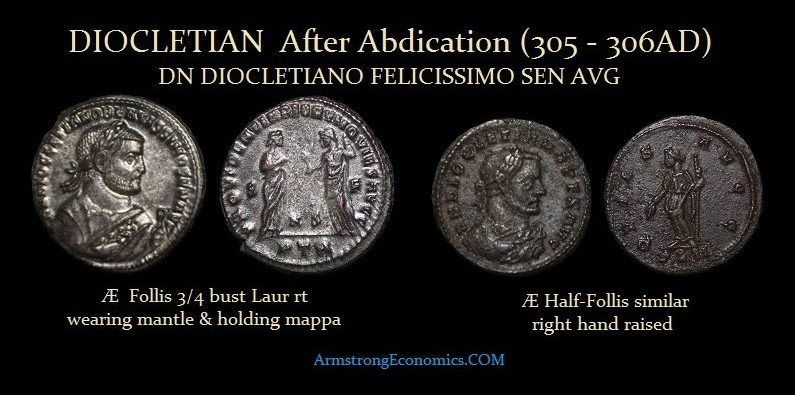Diocletian
284 – 305 AD
Died 316 AD
Gaius Aurelius Valerius Diocletianus was born to a poor family in Dalmatia (ILLYRICUM) during the mid-3rd century AD. Diocletian entered military service, where he displayed a talent for leadership, prompting his career to advance. By 284 AD, Diocletian became a member of the legions under Emperor Carus and continued to advance in the ranks reaching the position of the prestigious commander of the elite protectores domestici upon the succession of Emperor Numerian. It was through this position that they won the trust and loyalty of the legions in the imperial army stationed near Nicomedia. When Numerian died under very suspicious circumstances, the soldiers turned to Diocletian, demanding vengeance. It is said that many years before, a druidess had once predicted that Diocletian would one day become emperor. However, she also warned that first, he would have to slay the boar (aper). Whether this tale is true or not, it is impossible to say with such a distance in time. Nevertheless, the assassin of Numerian was the Prefect of the Guard Arrius Aper, who was brought before Diocletian, pronounced guilty and executed. According to tradition, once the prophecy was fulfilled (slaying of the “boar”) Diocletian was proclaimed Emperor by the troops.
Diocletian thus began on the road to solidify his claim to the throne. He crossed over the Bosporus in order to confront Numerian’s brother, Carinus. The victory came swiftly in 285AD, and Diocletian emerged as the sole ruler of the entire Roman Empire.
From the outset, Diocletian set about reorganizing the state. He worked over the next several years to bring his vision of a new order to fruition. Diocletian named his old friend, the reliable Maximianus, to be first his Caesar junior partner and then raised him to the rank of Augustus (co-emperor) in 286 AD. Maximianus aided Diocletian in all matters, and the next six years were spent in repairing the frontiers, the state, and above all the honor of the Roman Empire, which had been badly damaged by the chaos that dominated the previous 60 years.
Diocletian took as his patron the god Jupiter or Jove, and Maximianus chose Hercules. In their names wars were fought in Moesia, Pannonia, Gaul and Syria. With stability reestablished, Diocletian began to initiate the next step in his major program of imperial reform in 293 AD.
The chaos of succession from one emperor to the next bathed the Roman Empire in its own blood during the 3rd century. The economy collapsed, the silver content of money collapsed, and revenues often disappeared as bad money drove goods from circulation precisely according to Gresham’s Law.
Indeed, the silver coinage was reduced dramatically in size, weight, and silver content. The economy had reverted to barter. Diocletian knew that if Rome was to survive, it had to find a better method of providing for the peaceful transition of power once again. However, to avoid power being passed to an insane son, Diocletian also knew that succession had to be based upon ability rather than hereditary claims.
From these wise observations, Diocletian envisioned a new political order, which became known as the Tetrarchy. This political structure built upon the two ruler concept was attempted even by Carinus and Numerian. However, each Augustus (Emperor) in the East and West would also have a junior partner who held the rank of Caesar. It was Diocletian intent that the two Augustii would retire and then the two Caesars would advance thereby appointing two junior partners once again. While in loose terms, this structure could be argued to be similar to a President and Vice President, it failed to take into consideration that the power still resided within the hands of the military rather than the people. As a result, the best of intentions would not fulfill the dreams of Diocletian in the long run.
 The Tetrarchy was thus born with the two Augustii, Diocletian and Maximianus, being joined by the appointment of two Caesars; Galerius and Constantius I Chlorus. Diocletian and Galerius would rule in the East, and Maximian and Constantius I in the West. The Empire was still one entity, but from now on, the administration (under a Tetrarchy) would be better organized. As for the succession, this remained to be tested.
The Tetrarchy was thus born with the two Augustii, Diocletian and Maximianus, being joined by the appointment of two Caesars; Galerius and Constantius I Chlorus. Diocletian and Galerius would rule in the East, and Maximian and Constantius I in the West. The Empire was still one entity, but from now on, the administration (under a Tetrarchy) would be better organized. As for the succession, this remained to be tested.
With the political reforms in place, Diocletian then turned to the huge task of reforming the imperial government and military. Legions were changed to fit the adjustments in the provinces. Each ruler, the two Augustii and the two Caesars wielded a field army or the Comitatenses along with calvary and a new guard, the Scholae Palatinae, who replaced the now reduced Praetorian Guard. This military force would travel with the Emperor and be used specifically to strengthen the frontier troops (Limitanei), watching the borders when necessary. Any invasion on the part of the barbarians, even if successful in piercing the frontier defenses, would be destroyed by this vast personal imperial force (Comitatenses) and any additional Limitanei who might be deployed temporarily to the region of conflict.
Diocletian’s military reforms completely reorganized the chaotic structure of the legions, thereby reducing the often dangerous effect of legions being summoned by an Emperor and then revolting on behalf of their own general. This major military reorganization proved to be a stunning success in the numerous campaigns launched during Diocletian’s reign against Persia, Achilleus in Egypt, and in Britain, where Carausius followed by Allectus sought to reestablish independence.
Diocletian also instituted reforms within the provincial system as well. The number of provinces was actually doubled, and each province was included in the larger, DIOCESE unit, which came under the control of very powerful governors who, in turn, answered to one of each Emperor’s four Praetorian Prefects. This reformed system remained in place for many years and contributed to a more stable and efficient central administration, which was also seen as a deterrent against potential tyranny.
Diocletian also included Italy in his reform program, and as such, Italy was added to a diocese, which ended its unique centuries-old status of being exempt from direct taxes, rules, and regulations. Diocletian also realized that there would be fierce internal resentment within Rome once it lost its tax-free status and privileges. Consequently, Diocletian avoided the potential political traps so common in Rome by moving the capital to Ravenna, just outside of Milan. In the East, the capital was established at Nicomedia in Bithynia as his initial residence before moving to Antioch at the start of the Tetrarchy. Diocletian finally visited Rome in 303 AD and then only to celebrate the anniversary of his accession. Rome played no part in his grand plans, and he saw it as the source of ages of corruption. Still, Diocletian gave Rome many gifts, including a new curia and the Baths of Diocletian. Diocletian also embarked on major building projects across the Empire, and he particularly encouraged the opening of more schools. He also saw the vast influx of immigrants had led to the demise of communication and efficiency and worked hard to require Latin as the first official language of the Roman Empire.
Diocletian’s Wage & Price Controls
The political instability of the 3rd century had also caused massive inflation, which drove silver completely out of circulation. Thus, Diocletian instituted the first attempt by a government to impose wage and price controls. In 301 AD, Diocletian issued his famous Edict (Preamble) (Edictum De Pretiis Rerum Venalium), which fixed a maximum price for goods and services. While we do not have a complete version of this edict, fragments have been found in 30 ancient cities. It begins by stating its purpose was to instill price restraints and put an end to price speculation by profiteers. This gives us some insight confirming that speculation was rampant throughout the 3rd century as tangible goods and property rose in terms of nominal currency. This is a natural economic consequence, which has been documented throughout recorded history right up into modern times with the hyperinflation of Germany in the 20th century to the huge inflationary spiral unleashed during the 1970’s following the abandonment of the gold standard and fixed exchange rates in 1971.
Diocletian’s attempt at wage and price controls had the same success rate as those of Richard Nixon in the 1970’s – both failed! Lactantius commented at the time that the edict drove goods off the market creating an even larger black market. It is clear that the edict was not so much a ceiling for prices as it was an attempt to lower prices. Still, with this unrealistic approach to curbing price inflation, the edict reflected as much as a 7300% increase in the price of wheat from the previous century. Given the conservative attempt of the edict to control prices suggests that inflation must have been significantly higher, perhaps even in excess of 10,000% during the 3rd century AD. A papyrus of 335 AD shows wheat prices 6300% higher than the attempted ceiling of Diocletian’s edict, which warns that this attempt at wage and price controls was not successful. There is little doubt that this economic trend is very similar to modern economic history when silver was driven out of world coinage between 1965 – 1968 as inflation exploded and the national debt rose by more than 6000% by 1997.
Diocletian’s Monetary Reforms
Diocletian’s monetary reforms most likely took place as a series of events, perhaps over a 10-year period. His first step was to re-establish the gold aureus, which was struck at 60 to the pound (5.45 grams), whereas it had begun to suffer from weight reductions, particularly during the reign of Valerian I. However, the aureus had risen in weight once again under Aurelian, and by the time of Diocletian’s reign, the aureus was being struck loosely at 70 to the Roman pound of gold (4.67 grams). Diocletian’s reform was, in effect, a weight increase in an attempt to reduce inflation.
Next, Diocletian attempted to reestablish the base unit of the monetary system – the denarius. A new silver denarius was issued about 294AD with about the same weight and fineness as that of the denarii during the reign of Nero – 96 to the pound (3.41 grams). It appears that this coin was simply called the argenteus meaning silver. In documents that have survived from this period, it is clear that there are references made to “denarii” and “argenteus denarii” stressing the difference in obvious value. It is also important to note that the denarii, which had been so debased as to become merely a bronze token coinage similar to what we would call a penny, may not have been purchased very much at all. However, units of value were still expressed in terms of this debased coinage. This is similar to the Lira or Yen, which today are worthless in a single unit, yet value still continues to be calculated in Yen or Lira but only in multiples of 100’s, 1,000’s, 10,000’s, and so on.
By 294 AD, the bronze coinage underwent a major reform. A new denomination similar in size and weight to the As of the Julio-Claudian period was issued, known as the Follis. This reform saw a steady debasement until the bronze coinage eventually collapsed once again. It has been suggested that the following relationships may have prevailed:
AU Aureus = 24 Argentii
AR Argentius = 5 AE Follis
AE Follis = 5 Antoninianus
Antoninianus = 2 denarii
The “XXI” marking, first established in the reform of Aurelian, was removed from the newly reformed antoninianus and placed on the new follis. Metal analysis confirms that the follis contained on average about 4% silver whereas the reform antoninianus had little if any to speak of. Therefore, 5 follis may have indeed been equal to 1 (silver) argentius. However, with decades of massively produced debased antoninianii in circulation, that portion of the money supply had to still fit within the current monetary system. It could not be replaced, nor could it be canceled.
The question that arises is simple. What exchange rate prevailed between the old Antoninianus and the new follis? If we assumed a perfect world and the outstanding antoninianii were all 20% silver as prescribed by Aurelian’s reform, then 5 antoninianii contained 4 grams of silver. The follis, although larger in size and with a weight of 10 grams, should have contained only 2 grams of silver. If, indeed, the relationship between the denominations was as stated previously, then the follis was too heavy. Indeed, silver began to disappear and the follis fell 30% in weight by 308 AD. By 309 – 310 AD, the argenteus declined in silver content to less than 50% and began to take on the appearance of a bronze coin once more.
The Persecution of Christians
From Diocletian’s perspective, the Christian movement gained untold momentum. Within less than 20 years, Christianity would become the official religion of the Roman Empire. What Diocletian saw was economic and social chaos, and his solution was to reestablish the state religions and to persecute the Christians as if it were a punishment for destabilizing the state. Of course, the Christian movement had nothing to do with undermining the state, its frontiers, or the monetary system of the succession of ruler after ruler during the 3rd century. If anything, it was this very chaos that drove a greater number of the population into Christianity, which at least offered hope and comfort.
It was during the year 299AD when Diocletian and Galerius, a member of the Tetrarchy who was married to Valeria, the daughter of Diocletian, sacrificed to the Roman gods and sought an omen for the future with the barbarians trying to invade the Empire. The pagan priests, in their self-interest, claimed that they were unable to see the future because of the Christians in the imperial household. Diocletian ordered all associated with the royal household to sacrifice to the gods, and letters were sent to all military commanders demanding that the army be purged of Christian soldiers. It was in this purge that George a high-ranking decorated member of the military, declared himself a Christian and was imprisoned and tortured.
Nonetheless, his wife, Alexandra (282-304AD) was a compassionate and respected person. When she heard of disturbances among the military forces, she investigated to try to understand what this Christianity was all about. This is when she met the former soldier, George, in his prison cell after he had been severely tortured. Alexandra found that he was strangely calm, despite apparent pain and agony. She inquired about his motivation. George quietly told the empress about Christ, his teachings about love, his miracles of healing, his Crucifixion, and his Resurrection from the dead. Alexandra’s heart was opened to see Christianity. When George was sentenced to be beheaded, the Empress professed her belief in Christ to her husband.
Diocletian became angry with Alexandra for being “taken in” by the evil Christians and her public proclamation of converting to Christianity. Some said she was imprisoned and sentenced to be beheaded but died of natural causes in her cell two days before the execution of St. George. In other accounts, she was exiled to Syria and banned from the imperial palaces and public duties, which is the more likely outcome. To have sentenced her to death would have undermined the foundation of Diocletian’s administration.
The Christians remembered, and George became St. George the Great Martyr. Alexandra became St. Alexandra the Empress for her compassion. The fourth member of the Tetrarchy was Constantius I, who was married to Helena (c 248-328AD), and their son, Constantine, was born about 272AD and would become emperor one day and champion Christianity. Little is known of Helena’s life for more than 30 years after her son was born. To join the Tetrarchy, Constantius was compelled to marry in 289AD to Theodora, the daughter of Diocletian’s co-emperor Maximianus. It is presumed that Helena and Constantius were then divorced. When her son became Emperor, she used her station to search the Empire for the holy places of Christianity. She is known as also the discoverer of the “true cross.”
In 304 AD, Diocletian suffered an illness that helped to convince him that it was time for him to relinquish his powers. On May 1, 305, Diocletian abdicated, convincing the reluctant Maximian to join him. Galerius and Constantius I followed as the two Augustii. Content that the Empire would be capable hands, Diocletian retired to an estate of great luxury in Illyricum at SPLIT. There he spent most of his time in his gardens, growing his favorite vegetables.
In 308 AD, the political reforms that he instituted were tearing the Tetrarchy apart. He was summoned in 308 by Galerius to Carnuntum, where he was offered the throne once again but refused. Diocletian’s last years were spent watching in frustration as Constantine I, Maxentius, and others slaughtered one another in the name of ambition and the Empire. Roman blood was once again splashed over the landscape of the Empire. Diocletian finally died in 316 AD. He lived long enough to see his monetary, social, and political reforms go up in flames.
Still, Diocletian’s efforts served as a model for Constantine I the Great, who also reformed the economy, monetary system, and the government following Diocletian’s ideas of a centralized government. Eventually, Diocletian’s basic reforms also provided the direction for the Byzantine Empire, which also attempted to control everything within its realm. Indeed, Diocletian had proved himself to be a brilliant administrator and an excellent general. What he did not know was that he became the architect of imperialism into the 5th century and beyond.
Monetary System
Mints: Alexandria, Antioch, Arelate, Constantinople, Cyzicus, Heraclea, London, Lugdunum, Nicomedia, Rome, Siscia, Sirmium, Thessalonica, Ticinum, Treveri
Obverse Legends:
DIOCLETIANVS AVG
DIOCLETIANVS P F AVG
IMP DIOCLETIANVS AVG
IMP DIOCLETIANVS P F AVG
IMP C DIOCLETIANVS P F AVG
IMP C C VAL DIOCLETIANVS P F AVG
After Abdication
D N DIOCLETIANO BAEATIS
D N DIOCLETIANO FELICISSIMO SEN AVG
D N DIOCLETIANO P F S AVG
D N DIOCLETIANO FELICIS
DENOMINATIONS
Pre-Reform
AU Aureus (4.67 grams)
AU Quinarius (2.33 grams)
Æ HEAVY Antoninianus (4.8 grams)
Æ Antoninianus (3.67-2.8 grams)
Æ Denarius (2.09 grams)
Æ Quinarius (1.5-2.17 grams)
Æ Semis
Post-Reform
AU Aureus (5.45 grams)
AR Argenteus (3.32 grams)
AR Reduced Argentius (2.4 grams)
Æ Follis (10.1 grams)
Æ Antoninianus (4.6 grams)
EGYPT MONETARY REFORM 297/298AD
Diocletian instituted a monetary reform throughout the Empire in 296 AD. This time, he also applied this to all of Asia, including Egypt, in 297/298AD. Diocletian’s reform ended the Egyptian closed currency system, under which it had functioned for the previous 600 years when introduced by Alexander the Great when he conquered Egypt in 332-330 BC and unified the Empire monetarily under one set of coinages. Therefore, this terminated the run of Egyptian tetradrachms which had long been reduced with inflation from silver to bronze.
After Abdication
Æ Follis (10.1 grams)
Æ 1/2 Follis
Æ 1/4 Follis





















